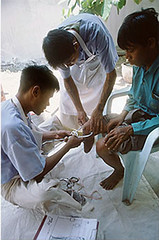
Clear Path International supports a group of medical technicians from the Karen Handicap Welfare Association who go with members of the Back Pack Health Workers Team to measure, deliver and fit prostheses for internally displaced Karen landmine accident survivors inside Myanmar. This is the backpackers' dire assessment of the general health conditions in which their people live.
Eastern Burma is now one of the world�s worst health disasters
The report entitled �Chronic Emergency,� released by the Backpack Health Worker Team (BPHWT), is the result of systematic surveys in communities of internally displaced persons living in the eastern conflict zones of Burma and provides the first glimpse of their health status.
The report shows that decades of civil war have decimated the health of these populations, with standard health indicators ranking this area amongst the worst in the world. The report also demonstrates that human rights abuses such as forced relocation, violence, forced labor, and the destruction of food and crops are common and serve as major drivers of the health crisis.
Launching the report, Thai Senator Jon Ungphakorn, a member of the ASEAN Inter-Parliamentary Myanmar Caucus, blamed the Burmese regime for the ongoing health crisis in eastern Burma.
�With abysmal statistics like these, it is no wonder the regime tries so hard to hide them from the world. The Burmese military junta is the source of the problem, not only through its abuses and neglect of the welfare of the people, but also through increasing restrictions on humanitarian aid efforts, particularly to ethnic minorities living in rural Burma.�
The BPHWT are a multi-ethnic group of mobile medical teams serving displaced people in Eastern Burma. Dr Cynthia Maung, a founding member of the BPHWT, recipient of the Magsaysay Award and a Nobel Peace Prize nominee in 2005, says eastern Burma is a humanitarian disaster zone.
�One out of twelve women may lose their life giving birth. Displaced people are 2.4 times more likely to have a child die than people not displaced. Their children, if they do survive, are more likely to be malnourished. Most of these deaths and illnesses are preventable.�
According to statistics from international agencies such as UNICEF, Burma�s national figures for infant and child mortality already rank amongst the worst in Southeast Asia. Adds Dr. Maung, �In eastern Burma it is even worse, infant and child mortality is twice as high. In displaced areas, one-in-five children will die before their fifth birthday and over 15 percent of children suffer from malnutrition.�
Despite the scale of the crisis, the junta has instead exacerbated the situation, launching the biggest offensive in eastern Burma for a decade in February of this year, displacing an additional 18,000 people.
The BPHWT report concludes that without addressing the factors which drive this health crisis, such as the human rights abuses and inability to access healthcare services, there can be no sustainable solution to this chronic emergency.
For more information please contact:
- Dr. Cynthia Maung ( phone. 09-9615054 )
Note: ( 18:00 to 21:00 hrs Bangkok Local Time)
- Mahn Mahn ( phone. 07-9438750 )
To see the full report please visit www.bphwt.org
 Clear Path International supports a group of medical technicians from the Karen Handicap Welfare Association who go with members of the Back Pack Health Workers Team to measure, deliver and fit prostheses for internally displaced Karen landmine accident survivors inside Myanmar. This is the backpackers' dire assessment of the general health conditions in which their people live.
Clear Path International supports a group of medical technicians from the Karen Handicap Welfare Association who go with members of the Back Pack Health Workers Team to measure, deliver and fit prostheses for internally displaced Karen landmine accident survivors inside Myanmar. This is the backpackers' dire assessment of the general health conditions in which their people live.
No comments:
Post a Comment